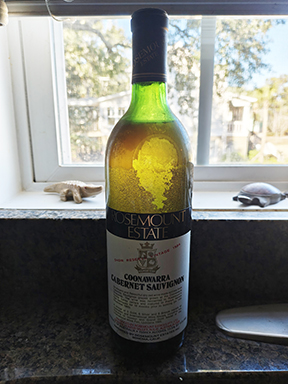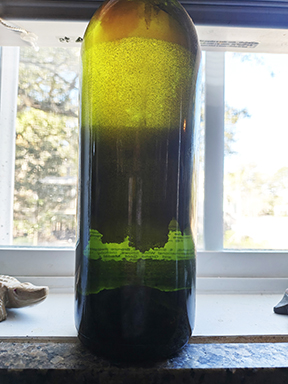

A. Ah, the joys (and occasional shocks) of rediscovering long-forgotten bottles! Your 1984 Australian Cabernet, now ghostly pale with all its color settled at the bottom, is a fascinating case study in the chemistry of long-term wine aging. You’re absolutely right to assume something unusual has occurred. While I wouldn’t place any bets on its drinkability, your instinct to explore the “why” behind this transformation is a good one. I’m curious myself, so let’s dig in.
Why Did the Color Drop Out?
The color of red wine comes from anthocyanins, the pigments found in grape skins. Over time, these compounds interact with tannins, oxygen, acidity, and the unique microbial world within each bottle, leading to gradual shifts in hue and intensity. Normally, an aged red will transition from deep purple to garnet and eventually to a faded brick or brownish-orange color. In your case, the color hasn’t just faded — it’s completely precipitated out. What caused this extreme loss? Likely a combination of the following factors:
Polymerization and sedimentation: Over time, anthocyanins and tannins bind together into larger molecules, some of which become too heavy to remain in solution. These compounds gradually settle as sediment. In your bottle, this process seems to have gone into overdrive, stripping nearly all the color from the liquid.
Oxidation and chemical breakdown: If the cork allowed tiny amounts of air to seep in, or if large amounts of oxygen was present during bottling, oxygen exposure could have accelerated pigment degradation. Anthocyanins break down over time, especially when oxidation occurs.
Wine pH and tannin-acid balance: Some wines are naturally more prone to pigment instability. A higher pH can make anthocyanins less stable, while an imbalance between tannins and acidity may cause premature precipitation.
Bottle microbiome: Don’t forget that each lot of wine, and eventually each bottle, is its own unique microbiological world. Bacteria and yeast are all around us in the air we breathe and even “sterile-filtered” wine can encounter small amounts of microorganisms on the glass bottle and cork. Though bottled wine is a pretty tough environment for most microbes, some can still slowly grow and metabolize in a low-pH, higher-alcohol environment, creating tiny changes in the wine chemistry over time. Sometimes these tiny changes can create a domino effect, pairing with other factors in this list, to contribute to color loss, change, and precipitation over time.
Storage conditions and bottle variation: Even if both bottles were stored in the same cabinet, tiny differences in temperature, humidity, or cork performance could have influenced how each aged.
Can You Drink It?
Technically, yes. But will it be enjoyable? That’s another matter entirely. If you’re feeling adventurous, follow these steps before taking a sip:
Inspect the wine visually: If it’s clear (aside from sediment), that’s a better sign than murkiness or haze, which could indicate microbial spoilage.
Give it a sniff: Aromas of vinegar, wet cardboard, or nail polish remover mean oxidation or volatile acidity has taken over. If it smells reasonably like aged wine (dried fruit, earth, leather), you might have a chance.
Taste with caution: If it doesn’t immediately make you regret your decision, you may learn something interesting about how wine’s structure holds up (or doesn’t) over decades.
Most likely, this wine has lost its structure, balance, and any remaining fruit character, leaving behind a thin, oxidized shadow of what it once was. But if you do decide to taste it, let curiosity be your guide!
How Does Aging Affect Red Wine Color?
Your bottle presents an extreme case, but red wine’s color evolution over time follows a predictable pattern:
Young reds (1–5 years): Deep purple or ruby hues dominate, thanks to high anthocyanin concentration.
Maturing reds (5–10 years): Vibrant colors soften to garnet as pigments bond with tannins and start settling out.
Aged reds (10–25 years): Brick red hues emerge as anthocyanins degrade further. The wine becomes more translucent, with sediment increasing.
Very old reds (25+ years): The last remnants of pigment may fully precipitate, leaving behind a pale, brownish, or even nearly colorless liquid.
Some factors influence how well a wine holds its color: Acidity (lower pH wines retain color better), tannin structure (more tannins help stabilize pigments), and variety (Cabernet Sauvignon, Nebbiolo, and Bordeaux blends tend to age gracefully, while lighter reds may fade faster).
Why Did One Bottle Keep Its Color?
The fact that another bottle from the same vintage didn’t suffer the same fate is intriguing, but not entirely surprising. Even among wines from the same batch, small variations can lead to vastly different aging outcomes:
Cork integrity: One cork may have provided a better seal, limiting oxidation.
Micro-oxygenation differences: Tiny variations in oxygen exposure at bottling or during storage can influence color stability.
Storage conditions: Slight fluctuations in temperature or humidity, even within the same cabinet, can impact how a wine ages.
Microbial fingerprint: Slightly more natural yeast or bacteria living on a cork or in a bottle can create subtle bottle-to-bottle variations.
Tips for Aging Wine
For best long-term color retention and quality preservation, keep these key storage principles in mind:
Store bottles on their side: This keeps the cork moist and prevents excessive oxygen ingress.
Maintain a consistent, cool temperature: 50–55 °F (10–13 °C) is ideal for slowing chemical reactions.
Minimize light and vibration: UV exposure can accelerate pigment breakdown, and excessive movement can disturb sediment formation.
Choose wines built for aging: Higher-acid, tannic reds with balanced structure tend to best stand the test of time.
Your “ghost Cabernet” is certainly an oddity, but it offers a rare glimpse into wine chemistry in action and is a reminder of how unpredictable and fascinating wine aging can be. If you do take a sip, I’d love to hear your tasting notes — just don’t expect to pour a second glass!





